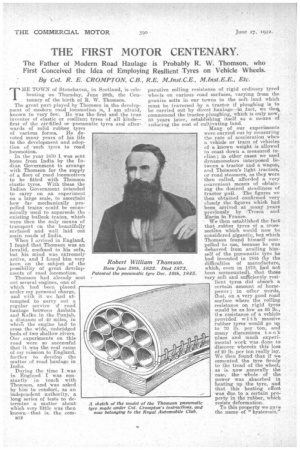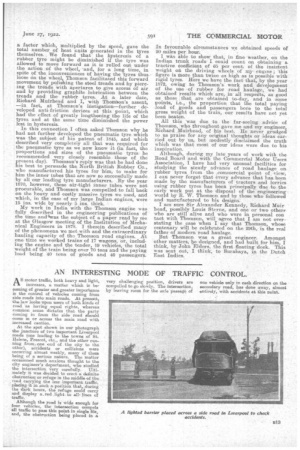THE FIRST MOTOR CENTENARY.
Page 10

Page 11

If you've noticed an error in this article please click here to report it so we can fix it.
The Father of Modern Road Haulage is Probably R. W. Thomson, who First Conceived the Idea of Employing Resilient Tyres on Vehicle Wheels.
By Col. R. E. CROMPTON, CB., R.E. M.Inst.C.E., M.Inst.E.E., Etc.
THE TOWN of Stonehaven, in Scotland, is celebrating on Thursday, June 29th, the Centenary of the birth of R. W. Thomson. The great part played by Thomson in the development of modern road locomotion is, I am afraid, known to very few. He was the first and the true inventor of elastic or resilient tyres of all kinds— first of the air-filled or pneumatic tyres and after
wards of solid rubber tyres _ of various forms. He devoted many years of his life to the development and adoption of such tyres to road locomotion.
In the year 1870 I, was sent home from India by the Indian Government to arrange with Thomson for the supply of a fleet of road locomotives to be fitted with Thomson elastic tyres. With these the Indian Government. intended to carry on an experiment on a large scale, to ascertain how far mechanically propelled trains could be economically used to supersede the existing bullock trains, which were then the only means of transport on the beautifully surfaced and well laid out main roads of India.
• When I arrived in England, I found that Thomson was an invalid, confined to his sofa, but his mind was extremely. active, and I found him very keen on the subject of the possibility of great developments of road locomotion.
. Thomson had already sent out several engines, one of. which had been placed under my personal charge, and with it we had attempted to carry out a regular service if road haulage between Ambala and Kalka in the Punjab, a distance of AO miles, in whieTi the engine had to cross the ,wide, ennbridged beds of two shallow rivers. Our experiments on this road were so successful that it was the real cause . of my mission to England, further to develop the matter of road haulage in India.
During the time I was in England I was eon-. stantly in touch with Thomson, and was asked by him to conduct, as an independent authority, a long series of tests to -determine a matter about which very little was then known—that is. the cornn12
parative rolling resistance of rigid ordinary tyred wheels on various road surfaces, varying from the granite setts in our towns to the soft land which must be traversed by a tractor if ploughing is to be carried out by direct haulage—in. fact, we the% commenced the tractor ploughing, which is only now,50 years later, establishing itself as a means of reducing the cost of cultivating land. Many of our experiments were carried out by measuring
the rate of acceleration when a vehicle or train of vehicles of a known weight is allowed to coast down a measured in
cline; in other cases we used dynamometers interposed be tween a tractor and a wagon, and Thdroson's light tractors, or road steamers, as they were then called, afforded a very convenient means of obtaining the desired steadiness of tractor pull. The figures we then obtained confirmed very closely the figures which had been arrived at many years previously by IITI`Fiefl. and Merin 311 France.
We then established the fact that rubbei tyres of a cross section which would now be considered gigantic, but which Thomson found himself com pelled to use, because he was debarred from availing himself of the pneumatic tyre he had invented in 1845 (by the
difficulties of manufacture, which, even in 1870, had not
been surmounted), that these very soft and sufficiently resilient tyres did absorb a. certain amount of horse power ; in other words, that, on a very goad road surface where the rolling
resistance on rigid tyres would be as low as 50 lb.,
the resistance of a vehicle
provided with massive rubber tyres would go up to 70 lb. per ton, and
many discussions took place and much experi mental work was dope to
discover wherein this loss of 20 lh. per ton really lay. We then found that if we
cemented the tyre firmly to the tread of the wheel, as is now generally the case, the whole of the power was absorbed in heating up the tyre, and that this heating effect was due to a certain property in the rubber, which resists deformation.
To this property we gave the name of 0 hysteresis,"
a factor which, multiplied by the weed, gave the total number of heat units generated in the tyres themselves. We found that the hysteresis of a rubber tyre might be diminished if the tyre was allowed to move forward as it is rolled out under the action of the wheel, • 'and, for a long time, in spite of the inconveniences of having the tyres thus • loose on the wheel, Thomson facilitated this forward movement by polishing the steel treads and by piercing the treads with apertures to give access of air and by providing graphite lubrication between the treads and the rubber tyres. At a later date, Richard Muirhead and I, with Thonison's assent, —in fact, at Thomson's instigation—further developed anti-friction devices at this point, which had the effect of greatly lengthening the life of the tyres arid at the same time diminished the power lest in hysteresis.
In this connection I often asked Thomson why he had not further developed the pneumatic tyre which was the subject of his patent of 1845, and which described very completely all that was required for
• the pneumatic tyre as we now know it (in fact, the proportions and sizes of the pneumatic tyres he recommended very closely resemble those of the present day). Thomson's replywas that he had done his best to persuade the North British Rubber Co., who manufactured his tyres for him, to make for him the inner tubes that are now so successfully made by all our leading tyre manufacturers. By the year 1870, however, these air-tight inner tubes were not procurable, and Thomson was compelled to fall back on the heavy and costly massive tyres we used, and which, in the ease of my large Indian engines, were 15 ins, wide by nearly 5 ins. thick. My work in India with the Thomson engine was fully described in the engineering publications of the time andas the subject of a paper read by me at the Glasgow meeting of the Institution of Mechanical Engineers in 1878. I therein described many of the phenomena we met with and the extraordinary hauling capacity of the, Thomson road engines. At one time we worked trains of 17 wagons, or, including the engine and the tender, 19 vehicles, the total weight of the train being over 70 tons and the paying load being 40 tons of goods and 40 passengers. In favourable circumstances we obtained speeds of 20 miles per hour. I was able to show that, in fine weather, on the Indian trunk roads I could count on obtaining a tractive coefficient of 63 per cent. of the insistent weight on the driving wheels of my engine ; this figure is more than twice as high as is possible with rigid tyres. Here we have the fact that, by the year 1872, owing to Thomson's work and development of the use of rubber for road haulage, we had obtained results which are, in all respects, as good as those that are obtained to-day, and in some points, i.e., the proportion that the total paying load of goods and passengers bore to the total gross weight of the train, our results have not yet been beaten.
All this was due to the far-seeing advice of Thomson, who throughout gave me and my engineer, Richard Muirhead, of his best. He never grudged to us praise for any original thoughts or ideas carried out by us, but modestly disclaimed the truth which was that most of our ideas were due to his inspiration.
Although, during my late years of work with the Road Board and with the Commercial Motor Users Association, I have had very unusual facilities for studying the steady advance of road haulage on rubber tyres from the icommercial point of view, I can never forget that every advance that has been made by the manufacturers of tractors and lorries using rubber tyres has been prinoipally due to the early work put at the disposal of the engineering world by R. W. Thomson and by those who followed and manufactured to his designs.
I am sure Sir Alexander Kennedy, Richard Muir bead, possibly Louis Sterne, and one or two others who are still alive and who were in personal eon tact with Thomson, will agree that I am not overstating the case when I say that Thomson, whose centenary will be celebrated on the 29th, is the real father of modern road haulage.
But Thomson was a great engineer. Amongst other matters, lc designed, and had built for him, I think, by John Elders, the first floating dock. This was sent out, I think, to Surabaya, in the Dutch East Indies.






























